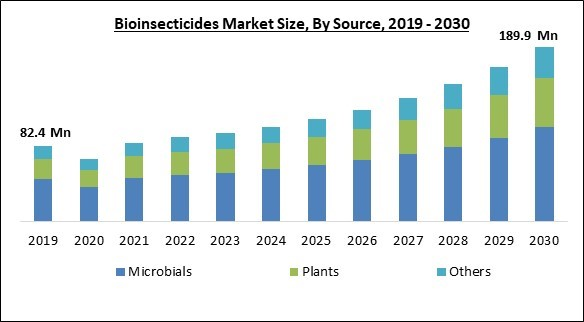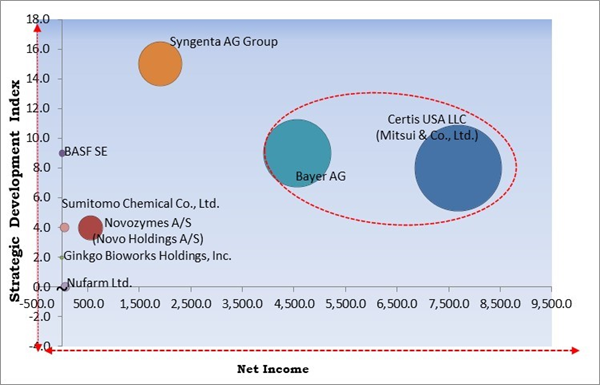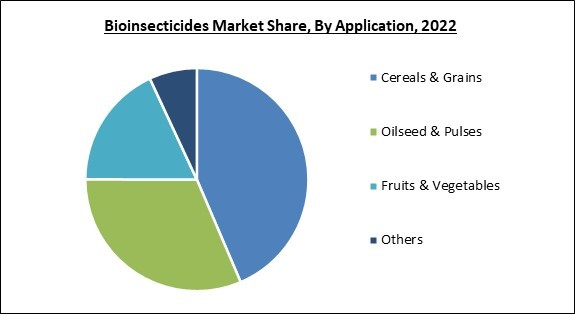The Global Bioinsecticides Market size is expected to reach $189.9 million by 2030, rising at a market growth of 10.2% CAGR during the forecast period. In the year 2022, the market attained a volume of 1,918.3 Kilo Litres, experiencing a growth of 2.2% (2019-2022).
Due to the expanding demand for eco-friendly and sustainable pest management solutions. Hence, the North America region is poised to acquire more than 30% share of the market by 2030. In addition, North America is home to several companies specializing in producing and developing bioinsecticides. These businesses are continually developing new and improved products that are more effective and simpler.
The major strategies followed by the market participants are Product Launches as the key developmental strategy to keep pace with the changing demands of end users. For instance, In March, 2021, Bayer launched Vynyty Citrus, the biological and pheromone-based crop protection product to control pests on citrus farms. In May, 2023, BASF announced the launch of Cimegra, an insecticide providing control of prevalent and difficult-to-control chewing insects.
The market research report covers the analysis of key stakeholders of the market. Key companies profiled in the report include BASF SE, Bayer AG, Certis USA LLC (Mitsui & Co., Ltd.), Novozymes A/S (Novo Holdings A/S), Biobest Group NV, Syngenta AG Group, Nufarm Ltd., Sumitomo Chemical Co., Ltd., Ginkgo Bioworks Holdings, Inc., and Vestaron Corporation
Due to the expanding demand for eco-friendly and sustainable pest management solutions. Hence, the North America region is poised to acquire more than 30% share of the market by 2030. In addition, North America is home to several companies specializing in producing and developing bioinsecticides. These businesses are continually developing new and improved products that are more effective and simpler.
The major strategies followed by the market participants are Product Launches as the key developmental strategy to keep pace with the changing demands of end users. For instance, In March, 2021, Bayer launched Vynyty Citrus, the biological and pheromone-based crop protection product to control pests on citrus farms. In May, 2023, BASF announced the launch of Cimegra, an insecticide providing control of prevalent and difficult-to-control chewing insects.
The Cardinal Matrix - Market Competition Analysis
Based on the analysis presented in the The Cardinal Matrix; Bayer AG and Certis USA LLC (Mitsui & Co., Ltd.) are the forerunners in the Market. In February, 2023, Certis Biologicals rolled out SoilGard, a microbial fungicide consisting of an easily usable granular formulation. Companies such as Syngenta AG Group, BASF SE and Sumitomo Chemical Co., Ltd. are some of the key innovators in Market.Market Growth Factors
Increasing issues of pest resurgence
The increase in pest resurgence due to resistance and ecological imbalances has created a need for sustainable and effective pest management solutions. Bioinsecticides, with their environmentally friendly and targeted approach, offer a valuable tool for mitigating the challenges posed by pest resurgence in agriculture. The increase in pest resurgence is indeed one of the driving factors behind the growth of bioinsecticides. By addressing the root causes of pest resurgence, such as the disruption of ecosystems through chemical pesticide use, bioinsecticides contribute to the long-term sustainability of agricultural systems. Hence, all these factors are propelling the growth of the market.Rise in adoption of organic food
The adoption of organic food has been a growing trend over the past several years, driven by various factors, including health concerns, environmental awareness, and changing consumer preferences. Organic food is produced using methods that avoid synthetic pesticides, chemical fertilizers, genetically modified organisms (GMOs), and certain other additives or processing methods. Organic food is often certified by recognized organizations that ensure adherence to specific production standards. This certification provides consumers with confidence in the authenticity of organic claims. Bioinsecticides are emerging as an important component of organic production. Therefore, as the demand for organic products increases, the demand will also increase.Market Restraining Factors
Brief life span of bioinsecticides
The relatively short shelf life of bioinsecticides is one of the challenges associated with these products. Bioinsecticides, which are derived from living organisms or natural compounds, can have a limited lifespan compared to some synthetic chemical pesticides. When the target pest is absent, the bioinsecticide may not have a purpose, reducing its effective life span. Also, bioinsecticides' relatively short shelf life can impact their commercial viability, as it may increase the costs associated with production, storage, and distribution. Hence, the short life span of bioinsecticides along with the factors mentioned above can hamper the growth of the market.Application Outlook
On the basis of application, the market is divided into cereals & grains, oilseeds & pulses, fruits & vegetables, and others. In 2022, the cereals and grains segment registered the highest revenue shares in the market. The consumption of these agriculture produce has increased due to the nutritional benefits of cereals and grains like rice, barley, maize, oats, wheat, and sorghum. These are predominantly applied to cereals and grains in Asia Pacific and North America due to the extensive wheat and maize cultivation in China and the United States. Typically, crop protection agents are recommended for cereals and grains.Source Outlook
Based on source, the market is segmented into microbials, plants, and others. The plants segment witnessed a significant revenue share in the market in 2022. These bioinsecticides harness the plant's natural defense mechanisms against insect pests. They offer an eco-friendly alternative to synthetic chemical pesticides, as they are often less harmful to non-target organisms, have lower environmental impact, and may be suitable for use in organic farming. For example, limonene is a natural insecticide derived from citrus fruits. It is a contact insecticide that disrupts the waxy cuticle of insects, leading to their dehydration and death. Limonene-based products are often used in household insect sprays.Regional Outlook
Region-wise, the market is analyzed across North America, Europe, Asia Pacific, and LAMEA. The Asia Pacific region acquired the maximum revenue share in the market in 2022. Based on the data from the Food and Agricultural Organization (FAO) and the Organization for Economic Co-operation and Development (OECD), the Asia Pacific region is the world's biggest producer of agricultural commodities. Due to population growth, arable land in the region is diminishing while food demand is rising. Therefore, producers progressively employ bioinsecticides to increase crop yield. The region is distinguished by its abundance of inexpensive labor and natural materials.The market research report covers the analysis of key stakeholders of the market. Key companies profiled in the report include BASF SE, Bayer AG, Certis USA LLC (Mitsui & Co., Ltd.), Novozymes A/S (Novo Holdings A/S), Biobest Group NV, Syngenta AG Group, Nufarm Ltd., Sumitomo Chemical Co., Ltd., Ginkgo Bioworks Holdings, Inc., and Vestaron Corporation
Strategies Deployed in the Market
Partnerships, Collaborations and Agreements:
- Apr-2023: Syngenta partnered with Biotalys, an Agricultural Technology (AgTech) company protecting crops and food. This collaboration aims to research, develop, and market the latest biocontrol solutions to manage important pests in a wide variety of crops. Moreover, this solution would be based on Biotalys’ AGROBODY™ technology and would provide a new mode of action to expand farmers' access to novel technologies that counter the threat of pest resistance and advance sustainable culture.
- Feb-2023: Bayer collaborated with Kimitec, a biotechnology company that provides natural and innovative agricultural solutions. This collaboration aims to bring modern Biologicals to millions of growers globally. Furthermore, both companies would focus on boosting the development and marketing of biological crop protection solutions and biostimulants.
- Jun-2022: Certis Biologicals collaborated with Novozymes, a company specializing in biosolutions. This collaboration aims to bring new solutions to row crop growers at a time when effective crop protection is more crucial than ever.
- Jun-2022: Bayer came into collaboration with AgroSpheres, Inc., a leader in developing the next generation of environmentally friendly crop protection products. Following this collaboration, both companies would aim to build novel modalities of biologicals for usage as crop protection products.
- Jun-2022: Novozymes came into partnership with Biotalys, an Agricultural Technology company protecting crops and food with protein-based biocontrol solutions. The partnership aims to broaden opportunities for Evoca™*, Biotalys’ first proprietary biocontrol.
- Jun-2022: Novozymes collaborated with Certis Biologicals, a pioneer in the development of biological pesticides. Through this collaboration, Novozymes aims to provide additional, efficacious solutions for growers of traditional row crops. Moreover, this would bring new solutions to row crop growers at a time when effective crop protection is more crucial than ever.
- Jun-2022: Bayer signed an agreement with MustGrow Biologics Corp., an agriculture biotechnology company focused on the development and commercialization of natural biological technologies. Under this agreement, both Bayer and MustGrow Biologics Corp. aim to analyse MustGrow’s biological technologies to find efficacy and commercial potential in key agricultural regions.
Product Launches and Product Expansions:
- Jul-2023: Syngenta India released Incipio and Simodis, plant protection solutions for vegetables, paddy, and cotton, in India. The launched products are based on PLINAZOLIN technology, delivering effective defense against multiple pests, making sure enhanced yields and crop quality.
- May-2023: BASF announced the launch of Cimegra, an insecticide providing control of prevalent and difficult-to-control chewing insects. With this launch, the company aims to offer Indonesian farmers effective and long-lasting protection of their crops.
- Feb-2023: Certis Biologicals rolled out SoilGard, a microbial fungicide. The product consists of an easily usable granular formulation that includes a living, naturally occurring soil fungus that is antagonistic to plant pathogenic fungi including fusarium, pythium, and Rhizoctonia.
- Feb-2023: Certis Biologicals introduced Kocide 50DF, the formulatin of the Copper Biofungicide. The Kocide 50DF comes with proven efficacy that growers have relied upon for generations, to serve more growers who require solutions to protect their crops sustainably and effectively.
- Jan-2023: BASF introduced Axalion Active, a novel insecticide active ingredient that controls harmful piercing and sucking insect pests, across Australia. The product would be used for Axalion-containing products including fruits, soybeans, legumes, cotton, cereals, beets, vegetables, oilseed rape, and ornamentals.
- Apr-2022: BASF released Exponus, an insecticide for farmers in India. With this launch, farmers would be able to protect their crops and accelerate productivity. The leading solution is powered by BASF’s new active ingredient, Broflanilide® in a specialized formulation. Moreover, the product delivers the latest mode of action for the control of key insect pests and provides farmers with a powerful, rapid &diverse tool for controlling a variety of insect pests and overcoming resistance to prevailing chemistries, as part of an integrated pest management program.
Acquisitions and Mergers:
- Jan-2023: Valent BioSciences LLC completed the acquisition of FBSciences Holdings, Inc., a leader in the discovery and commercialization of naturally derived plant, soil, and climate health solutions. Through this acquisition, Valent BioSciences and its parent company, Sumitomo Chemical Co., Ltd., provide an advanced suite of combined biorational solutions, consisting of biostimulants, biopesticides, and crop nutrition solutions.
- Jan-2022: Syngenta Crop Protection completed the acquisition of NemaTrident and UniSpore, the two next-generation bioinsecticides by Bionema, a creator of natural biopesticides, biostimulants and biofertilizers. This acquisition aims to combat rising resistance and a broad range of insects and pests in horticulture and ornamentals, turf amenities, and forestry, providing customers with better choices.
Scope of the Study
By Source(Volume, Kilo Litres, USD Thousands, 2019-2030)
- Microbials
- Plants
- Others
By Application(Volume, Kilo Litres, USD Thousands, 2019-2030)
- Cereals & Grains
- Oilseed & Pulses
- Fruits & Vegetables
- Others
By Geography(Volume, Kilo Litres, USD Thousands, 2019-2030)
- North America
- US
- Canada
- Mexico
- Rest of North America
- Europe
- Russia
- France
- Germany
- Poland
- UK
- Italy
- Rest of Europe
- Asia Pacific
- China
- India
- Indonesia
- Australia
- South Korea
- Japan
- Rest of Asia Pacific
- LAMEA
- Brazil
- Argentina
- Egypt
- South Africa
- Morocco
- Nigeria
- Rest of LAMEA
Key Market Players
List of Companies Profiled in the Report:
- BASF SE
- Bayer AG
- Certis USA LLC (Mitsui & Co., Ltd.)
- Novozymes A/S (Novo Holdings A/S)
- Biobest Group NV
- Syngenta AG Group
- Nufarm Ltd.
- Sumitomo Chemical Co., Ltd.
- Ginkgo Bioworks Holdings, Inc.
- Vestaron Corporation
Unique Offerings
- Exhaustive coverage
- The highest number of Market tables and figures
- Subscription-based model available
- Guaranteed best price
- Assured post sales research support with 10% customization free
Table of Contents
Chapter 1. Market Scope & Methodology
Chapter 2. Market at a Glance
Chapter 3. Market Overview
Chapter 4. Competition Analysis - Global
Chapter 5. Global Bioinsecticides Market by Source
Chapter 6. Global Bioinsecticides Market by Application
Chapter 7. Global Bioinsecticides Market by Region
Chapter 8. Company Profiles
Companies Mentioned
- BASF SE
- Bayer AG
- Certis USA LLC (Mitsui & Co., Ltd.)
- Novozymes A/S (Novo Holdings A/S)
- Biobest Group NV
- Syngenta AG Group
- Nufarm Ltd.
- Sumitomo Chemical Co., Ltd.
- Ginkgo Bioworks Holdings, Inc.
- Vestaron Corporation
Methodology

LOADING...











